Learn about the minimum 90ish things that a home inspector looks for and documents during a home inspection and what an inspector does not look for.
A home inspection is a comprehensive visual examination of a property typically performed during a real estate transaction. It’s crucial for both buyers and sellers in the home-buying process.
The Inspector’s Role: A home inspector visits the property to identify issues that could affect its value or pose safety risks. They thoroughly document the home’s overall condition and deliver a detailed report complete with pictures, narratives, and videos that explain what’s wrong and potential solutions.
This professional assessment helps buyers make informed decisions and gives sellers insight into their property’s condition before listing or proceeding with a purchase after a contract has been signed. The Inspection is a critical part of the overall home buying process and is a time sensitive event that must occur in a short window of time.
For Home Buyers: A $400-$1,000 inspection can uncover thousands of dollars in repairs needed. It also helps prioritize future maintenance and understand the home’s systems.
For Home Sellers: A pre-listing home inspection allows them to address issues proactively, potentially increasing sale price and reducing the risk of a deal falling through.
In this article, we’re going to cover the specific things that are covered in a Home Inspection performed by Tech Inspect Home Services. Tech Inspect Home Services, adheres to the InterNACHI (International Association of Certified Home Inspectors) and the Standards of Practice (SOP) provided by InterNACHI.
What Is a Home Inspection?
According to InterNACHI standards: A Home Inspection is a non-invasive, visual examination of accessible areas of a residential property that thoroughly documents the current condition of a property at the time of the inspection.
Now you’re probably wondering what does that all mean? Keep reading and it’ll make more sense.
Non-Invasive: This means an Inspector doesn’t tear things apart. An inspector cannot open walls, cut into drywall, or alter the condition of any part of the home. An inspector should leave the home, the same or better than they found it.
Visual Examination: In the context of a home inspection, visual examination means the inspector assesses components and systems using only their eyes and basic non-invasive tools—without dismantling, destroying, or deeply probing into the property.
Here’s what this means practically:
What Inspectors DO:
- Look at exposed surfaces, accessible areas, and visible components
- Use flashlights, moisture meters, electrical testers, and ladders
- Open electrical panels, run faucets, operate windows, and test outlets
- Walk on roofs (when safe), enter attics, and crawl through accessible spaces
- Observe signs of problems like stains, cracks, rust, or damage
What Inspectors DON’T DO:
- Remove wall coverings, flooring, or insulation to see what’s behind
- Disassemble appliances or HVAC systems
- Move furniture or stored items blocking access
- Perform invasive testing like opening walls for hidden pipes
- Predict future failures or guarantee conditions beyond what’s visible at the time of the inspection.
The Limitation: This means hidden issues—like pipes concealed in walls, wiring behind drywall, or problems covered by finished surfaces—may go undetected. Inspectors can only report on what they can reasonably see and access during their examination. This is why, Tech Inspect Home Services employ tools like a Thermal Imaging Camera. Using modern technology helps us extend our inspections and find things that could otherwise be unnoticed.
Think of it as a “check-up” rather than “surgery.” It’s thorough within its scope, but not exhaustive or destructive. This is why home inspectors often recommend specialized evaluations (structural engineers, roofers, electricians, hvac) when they spot potential concerns requiring deeper investigation. The specialists have the training to deep dive those systems and provide prescriptive solutions.
The Inspection Report:
The primary outcome provided to the clients of a home inspection is the inspection report. This provides the documentation that can be used to support negotiations, complete repairs, and make informed decisions.
You can learn more about Inspection reports in these blog posts:
Part 1: How to get the most out of your inspection report
Part 2: Inspection report categories – maintenance items
Part 3: Inspection report categories: defects – repair/replace
Part 4: Inspection report categories: defects – major concerns
You also preview Tech Inspect Sample Reports here for a better understanding of what / how inspections are documented.
The 10 Major Systems Inspected:
1. Roof Inspection
What’s Inspected:
-
- Roof-covering materials (from ground level or eaves)
- A type of roof covering material is shingles
-
- During this phase, the inspector looks for loose, damaged, missing shingles, the overall installation and overall condition of the roof covering.
- Is the roof pitch appropriate for the covering? For example, Asphalt Shingles should not be installed on a roof pitch of less than 2:12, the won’t shed water correctly if this is done.
- Missing Kickout Flashing – a common finding
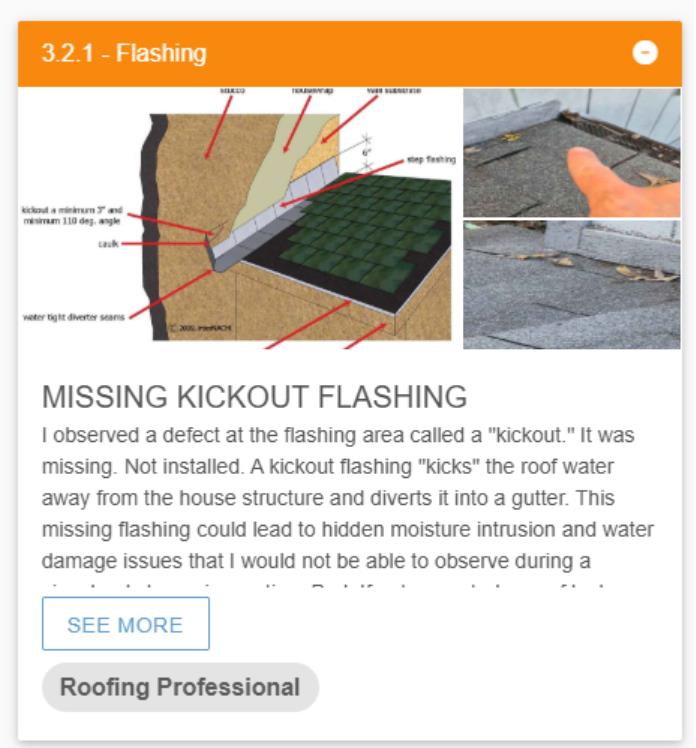
- Missing Caulk on Fasteners (Exposed Fasteners)
- Underdriven fasteners
- How many layers of roof covering material are present?
- For asphalt shingles, there should be no more than 2 layers. Otherwise, the weight may be more than the roof structure was designed to support and could result in structural damage.
- Gutters and Downspouts
- The inspector looks for damaged gutters, clogged gutters and overall gutter health.
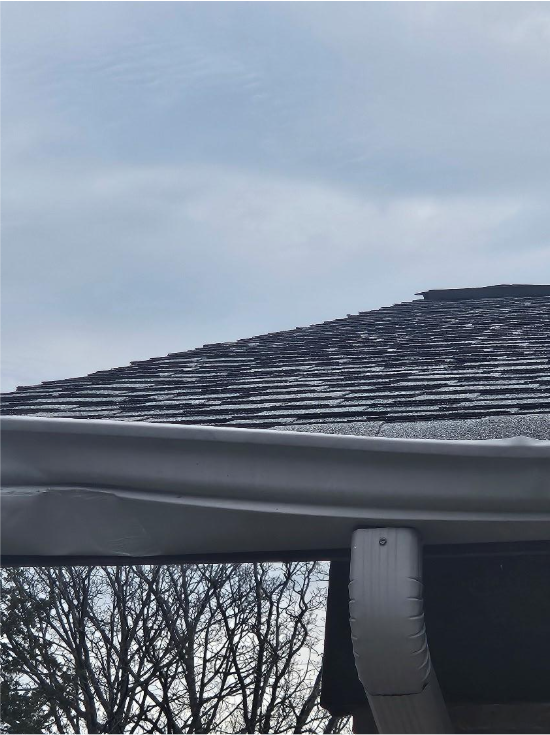
- The inspector also looks for the location of the downspouts, where they discharge to, and how the overall system is managing rain water.
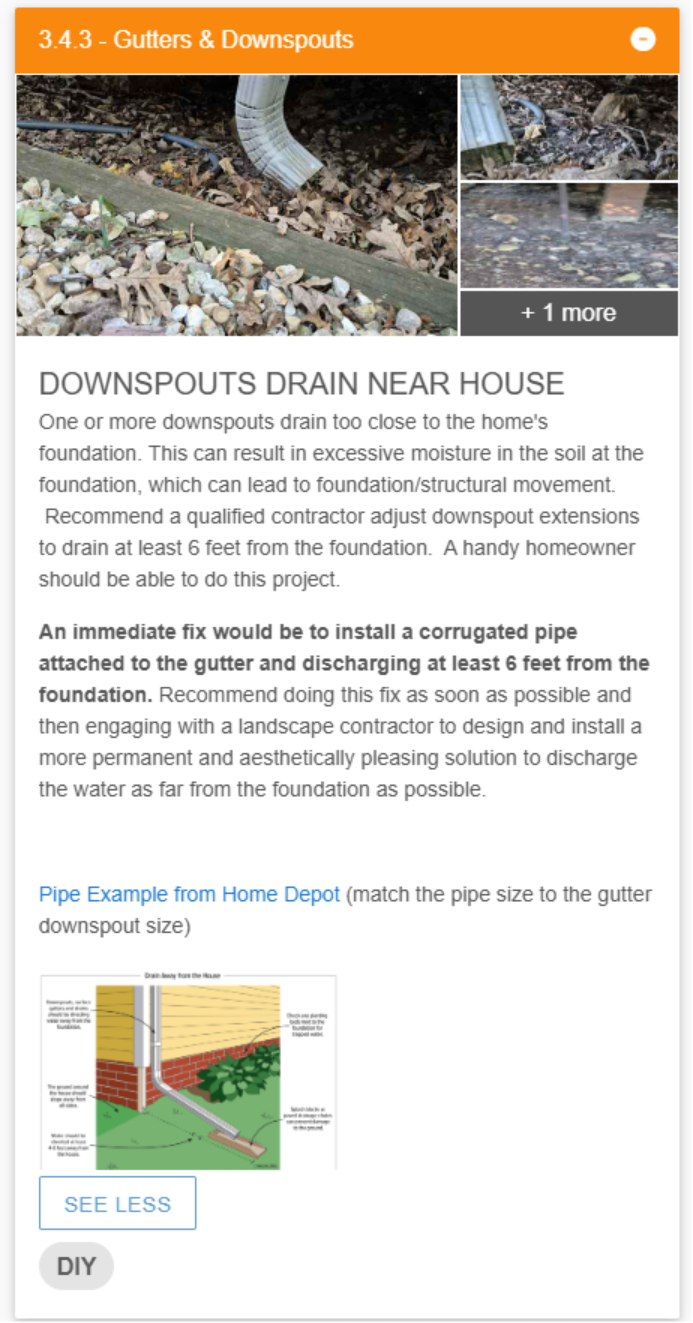
- Checkout this Case Study on the importance of a properly designed gutter system.
- The inspector looks for damaged gutters, clogged gutters and overall gutter health.
- Vents, flashing, skylights, and chimney
- Flashing is incredibly important to prevent water from accessing places it shouldn’t and causing damage to your home.
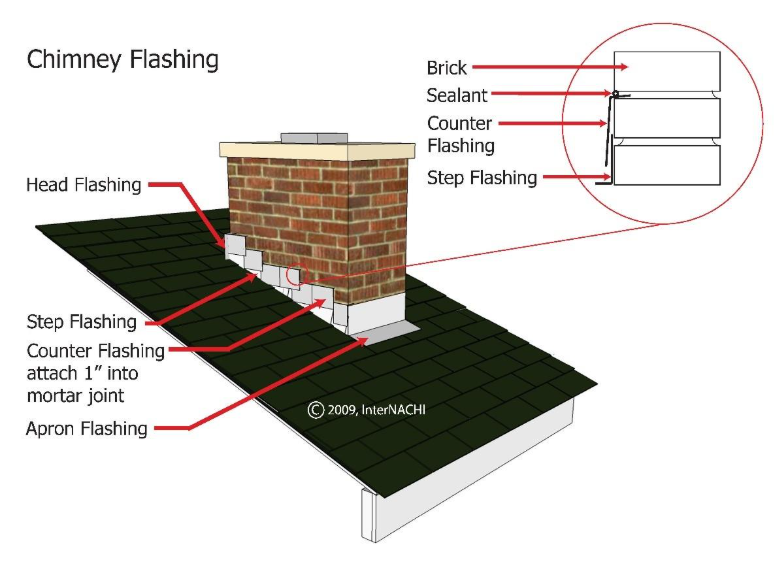
- Flashing is incredibly important to prevent water from accessing places it shouldn’t and causing damage to your home.
- Roof penetrations
- The inspector looks at the roof penetrations for installation issues and overall condition
-
- A type of roof covering material is shingles
- Roof-covering materials (from ground level or eaves)
What Inspectors Look For:
- Active roof leaks
- If it’s not raining, the inspector may not witness an active roof leak, but there may be signs or clues that this has occurred in the past or is currently occurring. All of which get noted and documented in the inspection report.
- Damaged or missing materials
- Proper drainage systems
What’s NOT Included:
- Walking on roof surfaces
-
- Per the SOP the inspector is NOT required to walk on roof surfaces
-
- Predicting service life
- Underground downspout pipes
- Removing snow, ice, or debris
Tech Inspect Home Services Approach to Roof Inspections:
2. Exterior Inspection
What’s Inspected:
- Exterior wall-covering materials
- What are the wall covering materials made of? Wood? Vinyl? Brick?
- Each wall covering material has its own installation requirements and can lead to protecting the home or causing issues.
- Eaves, soffits, and fascia
- Representative number of windows
- Do the windows open and close? Are they damaged?
- All exterior doors
- Do the doors open/close as expected or are there issues?
- Flashing and trim
- Missing Z flashing above windows and door is a common finding, it’s a simple component, but crucial to keeping water from getting into places it shouldn’t be.
- Adjacent walkways and driveways
- Overall condition
- Stairs, steps, porches, patios, decks, balconies
- Decks, porches and balconies are structure components that must be built correctly. According to InterNACHI: More than 2 million decks are built and replaced each year in North America. InterNACHI estimates that of the 45 million existing decks, only 40% are completely safe. Because decks appear to be simple to build, many people do not realize that decks are, in fact, structures that need to be designed to resist certain stresses adequately. Like any other house or building, a deck must be designed to support the weight of people, snow loads, and objects.
- Railings, guards, and handrails
- There are standards for that must be adhered to for railings:
- For Example:
- Railings must be spaced no more than 4 3/8” apart on stairs or 4” apart on horizontal runs. This is to prevent children from being able to get their heads stuck between the railings.
- There are also minimum/maximum height requirements.
- Vegetation, drainage, and grading (where they may affect structure)
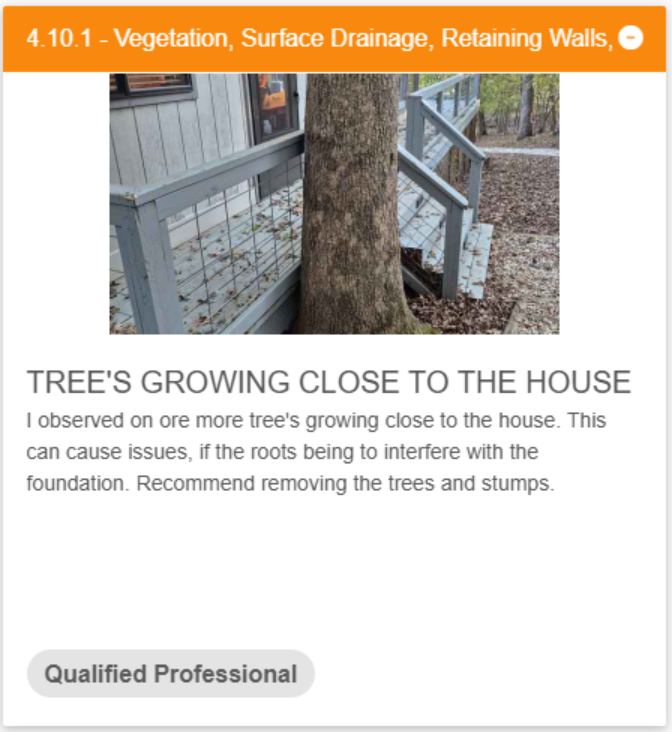
- There are standards for that must be adhered to for railings:
What Inspectors Look For:
- Improper spacing in railings and balusters
- Moisture intrusion issues
- Structural concerns
What’s NOT Included:
- Screens, storm windows, shutters
- Swimming pools or spas
- Septic systems
- Irrigation systems
- Underground utilities
3. Basement, Foundation, Crawl Space & Structure
What’s Inspected:
- Foundation type and condition
- Is the foundation, Cement Masonry Units (CMU’s), Poured Concrete? Basement? Slab? There are many variations of foundations, and having the foundation in good shape is important.
- Foundation issues can be extremely costly.
- Basement areas
- Crawl space (if accessible)
- Structural components
What Inspectors Look For:
- Wood in contact with soil
- Wood inContact with the soil can lead to premature wood rot, and provide an easy path for termites, which can cause extensive damage to a home’s structure if left unchecked.
- Active water penetration
- Foundation movement indicators (cracks, unlevel floors, out-of-square doors)
- Improper cutting or notching of structural members
What’s NOT Included:
- Entering inaccessible or hazardous crawl spaces
- If the inspector deems a space to be dangerous, then entry is not required per the inspector’s discretion.
- Engineering or architectural services
- The inspector is not an engineer but will be happy to refer you to one.
- Determining adequacy of structural systems
4. Heating System
What’s Inspected:
- Heating system operation using normal controls
- Thermostat location
- Energy source
- Heating method
What Inspectors Look For:
-
- Whether system operates properly
- When we call for heat at the thermostat did it turn on?
- Does the emergency Shut-Off Switch Work Properly?
- If it’s gas powered, do the flames on the burners look right? Did they ignite uniformly?
- Accessibility issues
- Can you get the heating system?
- Are all of the controls and shut-offs readily accessible? Can you get to them in an emergency?
- Whether system operates properly
What’s NOT Included:
- Interior of flues, chimneys, or heat exchangers
- To get into
- Fuel tanks or underground supply systems
- BTU capacity or adequacy measurements
- Lighting pilot flames
- If a pilot light is out, there’s probably a reason for it, at this point, we recommend having an HVAC company take a look at it.
- Testing when temperatures aren’t suitable
5. Cooling System
What’s Inspected:
- Cooling system operation using normal controls
- Thermostat location
- Cooling method
What Inspectors Look For:
- Whether system operates properly
- Did it turn on when we called for AC?
- Does everything appear to be running appropriately?
- A thermal camera is used to verify that the air is coming out of the vents correctly:
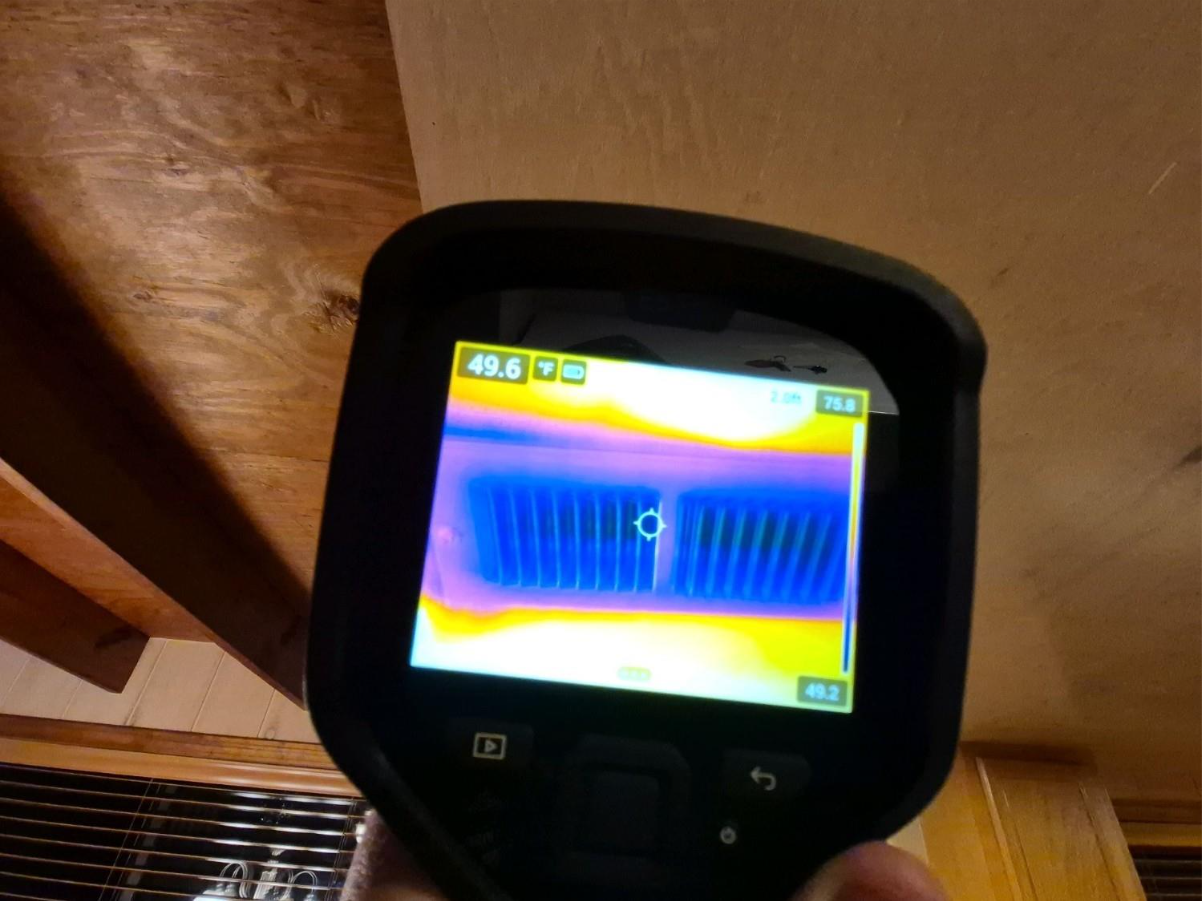
- Accessibility issues
What’s NOT Included:
- BTU or capacity measurements, determine if a system is appropriately sized is best left up to an HVAC professional, as those calculations, required special training.
- Portable or through-wall units
- Operation when exterior temp is below 65°F
- If the AC unit is turned on and the outdoor air temperature is below 65* it could damage the unit. We’ll document this as an inspection restriction.
- Refrigerant levels or leakage testing
6. Plumbing System
What’s Inspected:
-
- Main water supply shut-off valve
- Where is it located?
- Main fuel supply shut-off valve
- Where is it located?
- Are there any leaks at the fittings?
- Water heating equipment (including TPR valves, venting, seismic bracing
- A Temperature Pressure Relief (TPR) Valve, Should NOT:
- Be connected to the drainage system.
- Discharge through an air gap located in the same room as the water heater.
- Not be smaller than the diameter of the outlet of the valve.
- Serve a single relief device.
- Discharge to the floor.
- Discharge in a manner that does not cause personal injury or structural damage.
- Discharge to a termination point that is readily observable.
- Not be trapped (no P traps or S Traps)
- Be installed so as to flow by gravity.
- Terminate no more than 6 inches above the floor or flood level rim of the waste receptor. And not less than 2 times the discharge pipe diameter.
- Not have valves or tee fittings.
- Be constructed of materials listed or rated for such use.
- Be one nominal size larger that the size of the relief valve outlet, where the relief valve discharge piping is installed with insert fittings
- A TPR (Temperature and Pressure Relief) valve is a critical safety feature on water heaters that prevents dangerous pressure and temperature buildup within the tank.
- A Temperature Pressure Relief (TPR) Valve, Should NOT:
- Main water supply shut-off valve
- Safe Hot Water Temperature
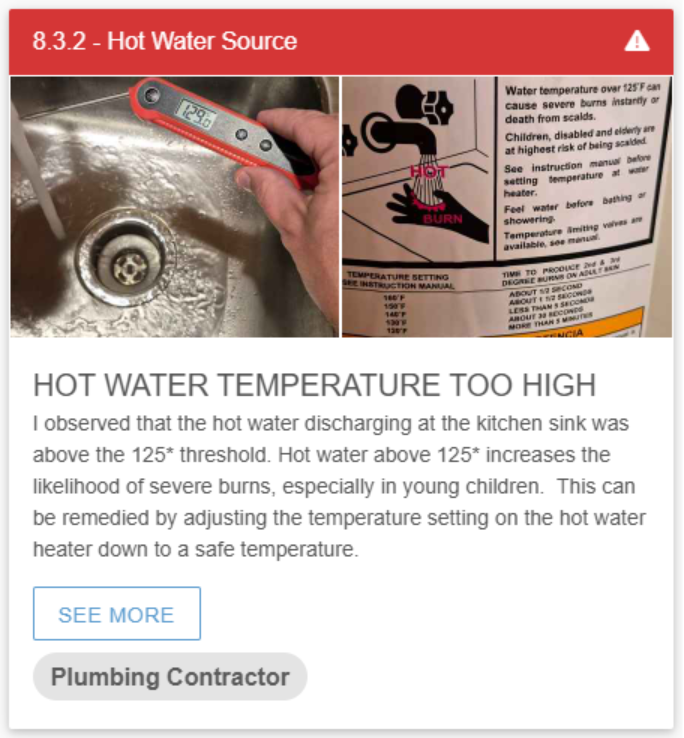
- Interior water supply (running all fixtures and faucets)
- All toilets (flushing for proper operation)
- Do the toilets flush?
- Are the toilets securely attached?
- Sinks, tubs, showers (testing drainage)
- We also look for leaks around the tubs, sinks, showers using our thermal camera and moisture meter.
- Drain, waste, and vent system
- Sump pumps with accessible floats
What Inspectors Look For:
- Deficiencies in water supply (testing two fixtures simultaneously)
- Hot/cold faucet installation issues
- Active plumbing leaks
- Toilet problems (damage, loose connections, leaks, malfunctioning components)
What’s NOT Included:
- Water quality or potability testing
- Exact flow rates or pressure measurements
- Clothes washing machine connections
- Operating valves
- Testing shower pan leakage
- Wastewater treatment systems
7. Electrical System
What’s Inspected:
- Service drop and overhead conductors
- Service head, mast, conduit
- Electric meter
- Service-entrance conductors
- Main service disconnect
- Panelboards and over-current protection
- Panel boards are a common place for wiring issues. Having things improperly wired in a panel board can result in electrical fires.
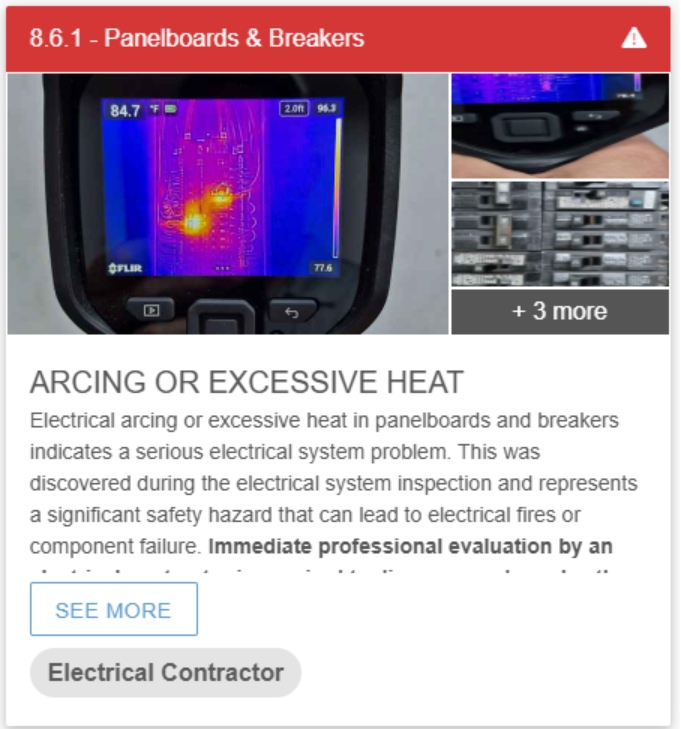
- Panel boards are a common place for wiring issues. Having things improperly wired in a panel board can result in electrical fires.
- Service grounding and bonding
- Representative number of switches, lighting fixtures, and receptacles
- GFCI and AFCI receptacles (tested where possible)
- Smoke and carbon monoxide detectors
What Inspectors Look For:
- Insulation deficiencies in service conductors
- Unfilled circuit-breaker panel openings
- Solid conductor aluminum wiring
- Non-functioning or improperly wired receptacles
- Polarity issues, arcing, or excessive heat
- Missing or improperly installed GFCI/AFCI devices
- Absence of smoke/CO detectors
What’s NOT Included:
- Inserting tools into electrical panels
- Removing panel covers
- Operating shut-down systems
- Low-voltage systems
- Security or alarm systems
- Generators or solar systems
General Electrical Information: Note on Electric Codes
The NEC (National Electrical Code) is regularly updated every couple of years. Homes are built at a point in time to the electric code in place at the time it was built. This means a particular home may not be up to current electrical codes. An example of this is the increasing requirement for GFCI (ground fault circuit interrupters) and AFCI (arc-fault circuit interrupters) protections in various parts of the home.
A general home inspection IS NOT a code inspection. The inspector may call out electrical defects in regard to current NEC requirements. Evaluation by a certified electrician will always be required to determine the best way to address any deficiencies in electrical equipment. As a homeowner, this presents an opportunity to have the electrical equipment within the home, reviewed thoroughly and updated to modern codes by an electrician.
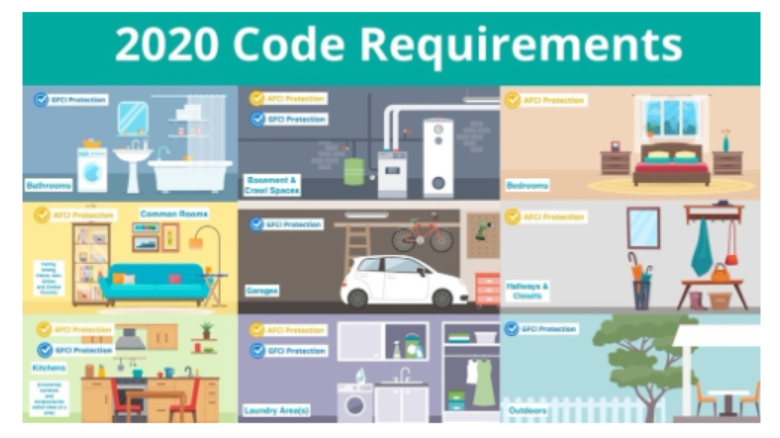
8. Fireplace & Chimney
What’s Inspected:
- Readily accessible and visible portions
- Are there any cracks or damaged parts of the fireplace?
- Lintels above fireplace openings
- Damper doors (opening/closing if accessible)
- Cleanout doors and frames
What Inspectors Look For:
- Joint separation or damage to hearth and chambers
- Dampers that don’t operate properly
- Absence of smoke/CO detectors in room
- Non-compliant cleanout materials
What’s NOT Included:
- Flue or vent system interior
- Operating gas fireplace inserts
- Lighting fires
- NFPA-style chimney inspections
- Determining need for chimney sweep
9. Attic, Insulation & Ventilation
What’s Inspected:
- Insulation in unfinished spaces (attics, crawl spaces, foundations)
- How much insulation is there? What types of insulation is installed? Are there any gaps in the insulation?
- Ventilation of unfinished spaces
- Is the home outfitted with soffit and ridge vent combinations? Or does the attic have gable vents?
- Does there appear to be enough ventilation?
- Mechanical exhaust systems (kitchen, bathrooms, laundry)
- Example: Do the bathroom exhaust systems vent to the outside?
What Inspectors Look For:
- General absence of insulation or ventilation
- Approximate insulation depth (reported in description)
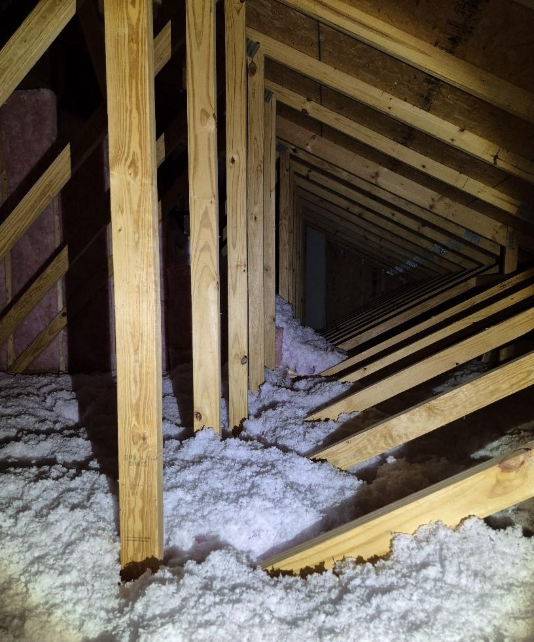
What’s NOT Included:
- Entering unsafe or inaccessible attics
- Moving or disturbing insulation
- Identifying R-value
- Determining composition of insulation materials
- Activating thermostatically controlled fans
10. Doors, Windows & Interior
What’s Inspected:
- Representative number of doors and windows (opening/closing)
- Floors, walls, and ceilings
- Stairs, steps, landings, stairways, ramps – do they meet standard measurements and seem to be stable and functional?
- Railings, guards, and handrails – do they meet standard measurements?
- Garage doors and opener operation
- There’s an entire section/checklist of functional checks the inspector will perform on garage doors.
-
- This includes checking the safety devices and overall function of the door.
-
- There’s an entire section/checklist of functional checks the inspector will perform on garage doors.
What Inspectors Look For:
- Improper spacing in railings and balusters
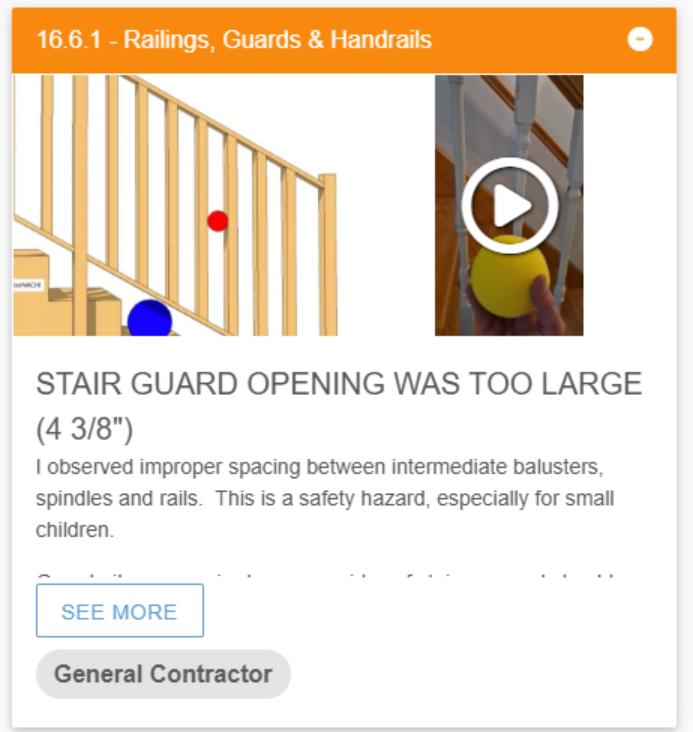
- Photo-electric safety sensors on garage doors
- Fogged windows or broken seals
What’s NOT Included:
- Paint, wallpaper, or finish treatments
- Floor coverings
- Security systems
- Household appliances
- Moving furniture or stored items
- Central vacuum systems
- Pools, spas, or fountains
Important Limitations & Exclusions
While there are a lot of things Inspectors DO during a home inspection and that the inspector is required to inspect per the InterNACHI standards of practice, there is also a lot of things that inspectors are NOT required to do or determine. It’s important that the Inspector has a limited amount of time at the property to perform the inspection, so that needs to be considered when reviewing what is in scope and out of scope. The inspection agreement signed by the client includes a detailed breakdown of what IS included and what is NOT included.
General Limitations:
- Not technically exhaustive
- A home inspection is a general inspection, and
- Won’t identify concealed or latent defects
- Doesn’t address aesthetic concerns
- Doesn’t determine market value or insurability
- Doesn’t predict service life expectancy
What Inspectors Won’t Test For:
- Pest infestations (rodents, insects)
- Mold, mildew, or fungus
- Mold testing is provided as a separate service that can be performed at the time of the inspection or at a future date.
- Radon or air quality
- Radon testing is provided as a separate service that can be performed at the time of the inspection or at a future date.
- Environmental hazards (lead paint, asbestos, toxic drywall)
- Electromagnetic fields
- Code compliance
Operating Restrictions:
- Won’t operate shut-down systems, if it’s turned off, then the inspector is not required to operate it. There’s probably a reason it’s turned off, and you should consult with the owner.
- Won’t test systems that don’t function properly
- For example, if we call for heat a couple of times on furnace and it doesn’t operate as expected, we’ll document that and recommend an HVAC technician.
- Won’t operate alarm systems
- Won’t dismantle or open systems
Understanding Material Defects
Material Defects vs. Normal Wear and Age: Understanding the Difference
According to InterNACHI (International Association of Certified Home Inspectors), understanding what constitutes a “material defect” is crucial for both buyers and inspectors.
Definition of Material Defect
A material defect is a specific issue with a system or component of a residential property that would have a significant adverse impact on the property’s value OR that poses an unreasonable risk to people. This is the standard InterNACHI-certified inspectors use when evaluating homes.
Important Distinction: Age ≠ Defect
A critical point: being near the end of its useful life does NOT automatically make something a material defect. An aging roof with 2-3 years of life remaining or a 20-year-old water heater functioning properly may need future replacement, but they aren’t defective if currently performing as intended. Inspectors note these as maintenance items or budget considerations—not defects.
Cosmetic/Normal Wear (NOT Material Defects):
- Minor wall cracks from settling
- Worn carpet or dated flooring
- Faded paint or outdated fixtures
- Small nail pops in drywall
- Aging appliances still functioning properly
- Normal weathering on exterior surfaces
Why This Distinction Matters
For Buyers: Understanding this difference prevents unrealistic expectations and unnecessary negotiation battles. You can focus repair requests on legitimate safety and value issues rather than cosmetic preferences. This strengthens your negotiating position and maintains goodwill with sellers.
For Negotiations: Sellers aren’t obligated to fix normal wear or upgrade aging-but-functional systems. Requesting repairs for material defects is reasonable; demanding new carpet because it’s old typically isn’t.
For Budgeting: Knowing what’s a true defect versus an aging component helps prioritize post-purchase expenses and avoid inspection anxiety over normal home conditions.
InterNACHI’s standard ensures inspectors report what truly matters while helping buyers maintain perspective on what’s reasonable to expect in a resale home.
What’s NOT Included in Standard Home Inspections
Quick reference list of specialized inspections buyers may need separately:
- Pest/termite inspections
- Radon testing
- Mold testing
- Septic system inspection
- Well water testing
- Swimming pool inspection
- Asbestos or lead paint testing
- Chimney Level 2 inspection
- Soil/foundation engineering
How to Prepare for Your Home Inspection
For Sellers:
- Ensure access to all areas, remove personal items and ensure clear access to important systems such as the electrical panel, HVAC system, Hot Water Heater.
- Replace any burnt out light bulbs
- Clear clutter from attics, crawl spaces, panels
- Unlock electrical panels and access points
- Turn on utilities
- Provide documentation for repairs/systems
For Buyers:
- Attend the inspection, if possible, in the last 30 minutes of the scheduled inspection time, for a summary report of the inspection. It’s advised against attending the entire inspection, as this prevents the inspector from being as thorough as possible and can lead to missed items.
- Prepare questions in advance
- Take notes on what the inspector tells you
- Don’t panic over minor issues
- Focus on defects, specifically material defects, not cosmetics (see above)
Understanding Your Home Inspection Report
At the beginning of the article, we linked to a Blog series that deep dives into the inspection reports. You can also learn more here.
At Tech Inspect, we’ve chosen to leverage what we believe is the best modern inspection software on the market, period. Why? Because you the client deserve the best!
Spectora-powered reports at Tech Inspect aren’t mere checklists written in word or photo dumps, they’re fully immersive, multi-view experiences. Whether you’re browsing the Full Report, glancing at the Summary, or zeroing in on Major Defects, every view is crisp, organized, and packed with HD pictures, diagrams and video. The delivered reports are easy to read on desktop or mobile
Frequently Asked Questions
Q: How long does a home inspection take?
A: Typically, 3-4 hours depending on home size and condition. On average, inspections document 90-100 different systems and components in the home which takes a fair amount of time. If a home inspector is spending less than an hour on an inspection, then the thoroughness and the quality of the inspection should be questioned.
Q: Should I attend my home inspection?
A: Yes, highly recommended for understanding issues firsthand, but only for the last 30 minutes. At this point, the inspector can provide a summary review of all the findings and give a more comprehensive overview of the home.
Q: What if the inspector finds problems?
A: Options include requesting repairs, negotiating price, or walking away, I recommend reading this article for more information.
Q: Are home inspections required?
A: Not legally required but highly recommended and often required by lenders.
Q: How much does a home inspection cost?
A: Varies by location and home size, you can get an instant and free quote for a specific property here.
Q: Can an inspection find everything wrong?
A: No – inspections are visual and non-invasive; some issues may be hidden and not able to be seen by the inspector at the time of the inspection.
Q: What’s the difference between InterNACHI and other inspection standards?
A: The home inspection industry has several major standard-setting organizations, with InterNACHI (International Association of Certified Home Inspectors) and ASHI (American Society of Home Inspectors) being the most prominent. InterNACHI is known for having the most comprehensive Standards of Practice and requires 24 hours of continuing education annually, while offering extensive free online training resources. The practical differences between these standards mostly involve scope of inspection, reporting requirements, and inspector qualifications. However, when hiring an inspector, the certification organization matters less than the individual inspector’s experience, report quality, communication skills, insurance coverage, and client reviews. A quality inspector from any reputable organization who follows professional standards and communicates effectively will serve clients well.
In Review: What Is a Home Inspection? A Complete Summary:
A home inspection is a non-invasive, visual examination of a property’s accessible areas that documents its current condition. Think of it as a thorough “check-up” for your potential new home—not surgery.
What Inspectors Actually Do:
Inspectors examine 10 major systems including the roof, exterior, foundation, heating/cooling, plumbing, electrical, fireplace, attic, and interior components. Using tools like flashlights, moisture meters, and thermal cameras, they assess visible components without tearing anything apart. They open electrical panels, test outlets, run faucets, and look for signs of damage like stains, cracks, or rust. In all they investigate and document at least 90 different items during an inspection, catching more and documenting more as they go.
Understanding the Limitations for a Home Inspector:
Inspectors cannot remove walls, disassemble systems, move furniture, or predict future failures. Hidden issues behind finished surfaces may go undetected, which is why inspectors sometimes recommend specialized evaluations from structural engineers, electricians, or HVAC professionals for deeper concerns.
Material Defects vs. Normal Wear on a Home:
Not everything flagged is urgent. A material defect significantly impacts property value or poses safety risks—like foundation cracks, active leaks, or faulty wiring. Normal wear like faded paint, worn carpet, or aging-but-functional appliances aren’t defects. An old water heater nearing replacement isn’t defective if it still works properly.
What’s Not Included in a Home Inspection:
Standard inspections don’t cover pest infestations, mold, radon, lead paint, septic systems, or pool inspections—these require separate specialized testing.
The Bottom Line
A home inspection protects your investment by revealing problems before you buy. The detailed report helps you negotiate repairs, budget for future maintenance, and make informed decisions. While not exhaustive, it provides crucial insight into your home’s condition and helps you avoid costly surprises after closing.
Attending the last 30 minutes of your inspection is highly recommended for a comprehensive summary of findings directly from your inspector.
Ready to Schedule Your Home Inspection?
Don’t leave the biggest investment of your life to chance. Whether you’re buying your dream home or selling your current property, a professional home inspection provides the clarity and confidence you need to move forward.
Get started today:
- 📋 Get an instant, free quote for your specific property
- 📞 Call us at 636-201-6366 to discuss your inspection needs
- 📅 Schedule your inspection online at a time that works for you
Questions about the inspection process? We’re here to help. Contact Tech Inspect Home Services and let our certified inspectors give you the peace of mind you deserve.
Tech Inspect Home Services uses state-of-the-art technology including thermal imaging cameras and delivers comprehensive Spectora-powered reports that are easy to read on any device. Serving St. Charles, Franklin, Warren, and Lincoln counties with professional, thorough inspections you can trust.
